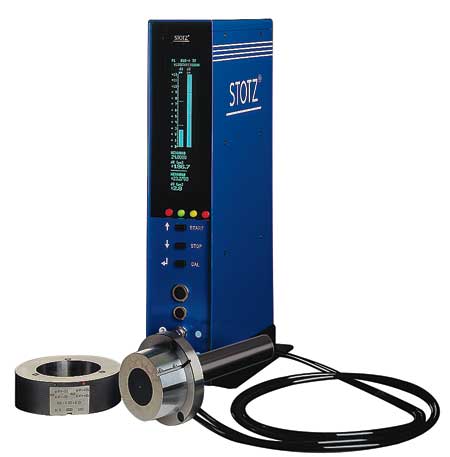

Photos show a Stotz air gauge and air ring. The shutdown mechanism on the air compressor is designed to reduce the air flow by 90% when the air gauge is not in use, thus saving substantial energy costs.
Air gauges are typically not in use approximately 90% or more of the time they are in a shop or QC department. Because these gauges function through the utilization of clean and dry compressed air in a high controlled flow, this relatively expensive commodity can cost an operation unnecessarily when not in use.
It would be impractical and inefficient to turn off the unit when not in use, as doing so would require an extended period of time to restart, balance and stabilize the measurement to achieve the desired accuracies. Since air gauging, by definition, requires the precise measurement of the airflow across the surface of the part being evaluated, this stabilization in the airflow is critical to running an efficient department and maintaining the proper protocol in measuring procedures.
However, what if the air column could be connected to a digital I/O regulator switch, to turn down the airflow, when the unit is not in use? Such technology is now available, and it offers substantial energy savings for any operation. The airflow can be restricted by as much as 90%, but it still flows at a consistent and measured level. By doing so, users can guarantee that the measurements taken when the air returns to full flow will be accurate and repeatable.
Such technology, to be optimally beneficial to a shop, must have the proper interface between the column and the power supply to function effectively. In one configuration, a proximity switch is positioned in the gauge holder and the airflow can be triggered when the gauge is removed from the holder.
Another means of arranging this type of controlled (but not entirely restricted) airflow is to use a pushbutton actuator on the face of the column control panel, or a foot pedal actuation could be possible.
While it is difficult to calculate the exact cost savings to a shop, owing to the various factors of on-time utilization and local energy costs, the fact remains that, in most shops, air is blowing as much as 95% of the time without being used for gauging. If compressors do not need to run, in order to produce this unused airflow, the savings can be substantial. On average, a 40% or better savings in direct energy costs per compressor would not be unreasonable to expect.
Operators who use air gauging at the present time should talk to a supplier about auto-shutoff switching and other forms of actuation for a reduction of compressor use. Such equipment can also be configured to upload the data on actual on/off time via an Ethernet or Profibus cable with RS232 or RS485 serial interface for monitoring of the energy consumption. This way, the validation of such an investment would be readily available to an operation. Also, on more sophisticated air columns, there would be no need for an external pressure regulator, as the column usually has such controls onboard.
Authored by Chris Koehn, Advanced Machine & Engineering
For more information contact:
Advanced Machine & Engineering Co. and Stotz
2500 N. Latham Street
Rockford, IL 61103
815-962-6076
info@ame.com
www.ame.com